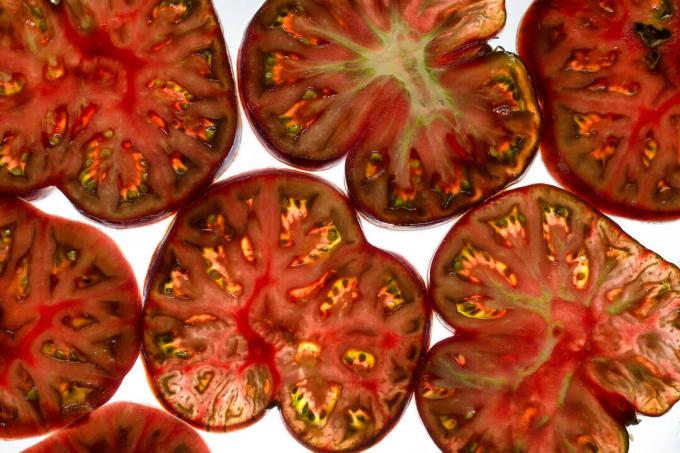The tomato variety 'Purple Calabash' has a special purple-red color. We show what you should consider when planting and caring for the beefsteak tomato.

The dark beefsteak tomato 'Purple Calabash' brings a special look to the garden and a particularly aromatic taste on the plate. In this portrait you will learn everything about the tomato variety 'Purple Calabash'.
contents
- Purple Calabash Tomato: Wanted
- Origin and history of the beefsteak tomato
- Characteristics and taste of the ‘Purple Calabash’ tomato variety
- Planting and caring for purple calabash tomatoes
- Harvesting and using Purple Calabash tomatoes
Purple Calabash Tomato: Wanted
| fruit | beef tomato; dark red to violet-brownish with dark to olive-green stylus |
| the taste | fruity, sweet, aromatic |
| maturing time | late |
| growth | Stick tomato, up to 160 cm |
| location | greenhouse, open ground, pot |
Origin and history of the beefsteak tomato
The 'Purple Calabash' variety has been known for a very long time and is one of the historic tomato varieties. Supposedly it was already cultivated in the area around Mexico in pre-colonial times, but this is difficult to prove. In 1963 it came into the hands of the USDA seed bank and has since been offered as an heirloom cultivar to hobby gardeners all over the world.
Characteristics and taste of the ‘Purple Calabash’ tomato variety
'Purple Calabash' reaches a height of about 160 centimeters as a plant. It produces large, heavily ribbed and flat-topped fruits that can weigh up to 200 grams. When ripe, the tomatoes take on a dark red to purplish-brown color, while the stem base is usually dark green to olive-colored. This variety ripens very late from the end of August to the beginning of September, when most other varieties are already starting to lose their yield. The taste of the 'Purple Calabash' is fruity and sweet with a unique aroma that you should try. This old variety is seedfast and can be propagated from its own seeds.

Planting and caring for purple calabash tomatoes
This strain is suitable for cultivation in a greenhouse, outdoors or in large pots. The 'Purple Calabash' has bursting fruits and is not particularly susceptible to disease. It can therefore also be placed outdoors, protected from the rain on a warm wall until it ripens earlier.
From mid-May after the ice saints, you can put the young plants of the 'Purple Calabash' outside, in the warmer greenhouse from the beginning of May. Ours is suitable for keeping in pots, but also for heavy and poor garden soil Plantura organic tomato soil. It already contains essential nutrients that enable the young plant to grow quickly after planting. The high compost content promotes soil life in the bed and can loosen and improve the soil structure over time. After planting, the 'Purple Calabash' should be watered vigorously and supported and tied with a metal or wooden stake.
Due to the size of the fruit and the very late ripening of the 'Purple Calabash', the tomato should only be grown with one shoot. The cutting out the tomato must be done regularly and carefully, as this variety tends to become rampant and overgrown if care is not taken.
From June it is worth fertilizing to prevent deficiency symptoms and to supply the plants with nutrients. A mostly organic long-term fertilizer, like ours Plantura organic tomato fertilizer, is worked into the surface of the soil as granules and thus provides the tomatoes with everything they need. After about two months, a lower dose of additional fertilization should be applied, which will suffice until the end of the season.
Harvesting and using Purple Calabash tomatoes
This aromatic beefsteak tomato is best eaten pure with just a little olive oil and salt, because that's how its taste comes into its own. Sliced on bread or in salads, the 'Purple Calabash' adds a dash of color. Of course, it can also be used for cooking, but it's actually much too good for that.
If you want to plant tomatoes unprotected in the bed, you have to pay attention to a few things in order to keep the plants healthy and get a rich harvest. We give tips on how to grow Tomatoes in the field and explain what to look out for when choosing a variety.



